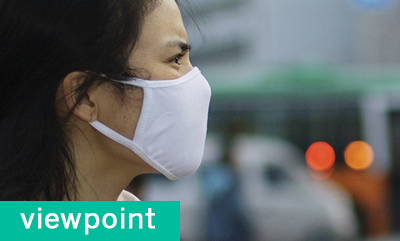Doing the Right Thing in Outbreak Management.
 Viewpoint articles are written by members of the SPH community from a wide diversity of perspectives. The views expressed are solely those of the author and are not intended to represent the views of Boston University or the School of Public Health. We aspire to a culture where all can express views in a context of civility and respect. Our guidance on the values that guide our commitment can be found at Revisiting the Principles of Free and Inclusive Academic Speech.
Viewpoint articles are written by members of the SPH community from a wide diversity of perspectives. The views expressed are solely those of the author and are not intended to represent the views of Boston University or the School of Public Health. We aspire to a culture where all can express views in a context of civility and respect. Our guidance on the values that guide our commitment can be found at Revisiting the Principles of Free and Inclusive Academic Speech.
My mother told me to “always try to do the right thing.” Good advice, although knowing what the right thing is can be hard, and doing it even harder. Maybe that’s why she used the word “try.” Her advice came to mind as I followed the worrisome news about the South Korean MERS-CoV outbreak. It poses the usual problems, all of them difficult, but also one new wrinkle.
The Current MERS-CoV Outbreak
MERS (Middle East Respiratory Syndrome) is caused by a coronavirus (hence the CoV), similar to the virus that causes SARS. Like SARS, the MERS virus can cause an extremely serious and often fatal respiratory disease. Evidence suggests it has been infecting humans undetected since at least 2007, but it wasn’t until 2012 that Egyptian virologist Ali Mohamed Zaki isolated and identified it in a patient from Saudi Arabia. Like most infectious diseases of humans, it was probably introduced from an animal reservoir. Preliminary evidence suggests it went from bats to camels and then to humans. The predominant population at risk until now has been health care workers. Indeed, MERS, like SARS, was first and foremost a nosocomial (hospital-associated) infection. As its name suggests, most cases have been associated with a particular geographic region, the Arabian peninsula. Saudi Arabia has had more than a thousand cases since 2012, with a formidable case fatality of 44 percent.
Now there is a new focus. On May 20, less than a month ago, a 68-year-old traveler to South Korea from Saudi Arabia was diagnosed with MERS. He first sought medical attention on May 11. In the nine days between hospitalization and his identification as a MERS infection, he transmitted the virus to various hospital workers and visitors. They then infected others, who in turn infected a third generation. Currently there are seven “fourth-generation” cases identified, including three in a 24-hour period. With SARS, an important feature transmission was the existence of cases called “superspreaders,” able to transmit the infection unusually easily. The Korean index case has the appearance of being a MERS superspreader, although this is not yet established.
The Korean MERS-CoV Outbreak
As of this writing (June 15), the South Korean case count stands at 150, 10 percent of whom have died. Seventeen of the current cases are medically unstable. The past 24 hours has seen five newly confirmed cases and two fatalities. Seventy of the cases (47 percent) were other patients in the hospital, and 54 cases (36 percent) were visitors and 26 cases (17 percent) health care workers. Besides the confirmed cases, another 120 people are under close evaluation. The government of South Korea has responded with extremely aggressive case finding, the closure of more than 2,200 schools and 20 universities, and the quarantine of almost 4,000 contacts at home or in government facilities. By all appearances, the authorities have been “doing the right thing.”
But last weekend, ProMed Mail Deputy Editor Marjorie P. Pollack, the moderator at ProMed[1], raised a fascinating point: “It’s ironic that the international community outside of South Korea has felt that the Koreans have been very transparent—much more so than the countries reporting cases of MERS-CoV infection on the Arabian Peninsula—yet we’ve overlooked the apparent lack of transparency in not mentioning the names of the involved hospitals and how that may have contributed to delayed awareness on the part of health care personnel as well as patients and visitors.”
Pollack went on to observe that this lapse is not specific to South Korean authorities. Indeed, the CDC, the European community, WHO, and most public health agencies “have a culture of not mentioning the names of hospitals, restaurants, hotels, etc. where there are outbreaks, especially early on before investigations have confirmed the locations are actually the source of the outbreak.” Doctors and patients shopping for premium facilities, as well as inattention to travel histories, can spread the outbreak, which can then be compounded by overcrowding and a lack of isolation facilities or single-bedded rooms at affected hospitals. Pollack asks the novel question: whether this lack of transparency might be an unrecognized problem in global public health.
What Is to Be Done?
Resource constraints aside, while all medical histories should include recent international travel, in this context the outcome could easily be stigmatization of particular geographic areas without benefit for most of its people, and potential harm for many of them. Perhaps it is justified in order to protect the rest of the world. Perhaps. But the history of attempting to isolate geographic areas or locales indicates it is ineffective, or worse, counterproductive. It’s a conundrum.
The question introduced here concerns the “culture” of non-identification in public health; what, then, are its roots? My colleague, Professor Jessica Leibler in the Department of Environmental Health, pointed out to me that often the culture has clear but unacknowledged origins not specific to public health. In recent avian influenza outbreaks on poultry farms, the US Department of Agriculture—not a health agency—has persistently blamed wild birds while allowing many corporations who manage flocks of a million or more birds in a single facility to pursue practices that facilitate pathogen emergence and transmission. As a result, consumers cannot influence these corporations in the marketplace. Are some of the same forces at work in public health, where health care facilities are seen as natural parts of the public health ecosystem?
In 21st-century public health, “doing the right thing” can get messy and unsatisfying. And if doing the right thing is ineffective, is it still “the right thing”? It’s complicated, to be sure, but we have to try. And trying in a clear-sighted way requires recognizing the obstacles.
Online resources for those wishing to learn about MERS-CoV or keep abreast of the situation:
- ProMed
- Center for Infectious Disease and Policy (CIDRAP)
- CDC
- WHO
- Wikipedia (about South Korean outbreak)
[1] If you don’t know about ProMED, this is a good time to get acquainted. ProMED stands for the Program for Monitoring Emerging Diseases. Started by volunteers (and still relying heavily on volunteer participation), it has been affiliated with the International Society for Infectious Diseases (ISID) since 1999. It is the largest Internet-based reporting system for emerging diseases and outbreak detection in humans, animals, and plants. It is also free. You can subscribe to their email notifications by clicking this link or search their website for the latest disease outbreak information.
 David Ozonoff is a professor of environmental health.
David Ozonoff is a professor of environmental health.